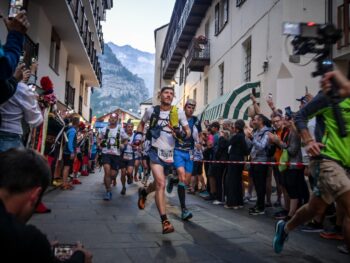Antoine Raberin with Guia Tagliapietra and the research group of Prof. Grégoire Millet, University of Lausanne, Switzerland.
Pulmonary function refers to how effectively the lungs enable breathing. During inspiration, the diaphragm contracts and moves downward, creating a pressure change that draws fresh air through the bronchial tree, from the trachea to the alveoli. Expiration begins when the diaphragm relaxes and moves upward, generating increased pressure, driving air out together with the elastic recoil of the lungs. This process, known as ventilation, is essential for oxygen delivery to the body.

While ventilation can be consciously controlled for short periods, the regulation of ventilation in response to oxygen demand is primarily unconscious. For example, during exercise, the increase in ventilation as exercise intensity rises is automatic and does not require voluntary control. Similarly, to compensate for reduced oxygen availability at high altitudes, humans experience an involuntary increase in ventilation.
To protect the lungs, inhaled air must be conditioned before reaching the lower respiratory tract. Conditioning airways warm and humidify the air to approximately 37°C and ensures it is fully saturated with moisture. In cold or dry weather, environmental stress may exceed the airways' capacity to condition air, potentially damaging the bronchial tree. This can lead to respiratory issues, especially when exercise increases ventilatory flow in such environments to meet the body's oxygen needs. Conditions like exercise-induced bronchoconstriction (formerly known as exercise-induced asthma) can resemble an asthma attack, occurring at the end of physical exertion and is common after exercise in dry and cold environment.

The Tor des Géants, a unique model of extreme pulmonary stress
The TOR330 - Tor des Géants race involves several factors that could stress pulmonary function. Firstly, as with any intense physical activity, the body's energy requirements increase, which leads to a corresponding rise in ventilation. Secondly, the average altitude of the race is approximately 2000 meters, where reduced oxygen availability drives increased ventilation and can cause pulmonary blood vessels to constrict. Additionally, air at this altitude is colder and drier, placing extra strain on the respiratory system. Finally, the race is a prolonged event, taking several days to complete, exposing participants to significant variations in temperature and humidity with day and night cycle, sleep deprivation, and sustained sympathetic nervous system activity to maintain their effort. Collectively, these factors create significant stress on pulmonary function, drawing the attention of exercise physiologists.
In 2015, Vernillo et al. studied for the first time the pulmonary function on the Tor des géants and documented a significant decline in lung function at approximately the midpoint of the race (148.7 km), with an even more pronounced drop at the race's conclusion. They reported a decrease in forced vital capacity (the maximum volume achieved during a forced inspiration and expiration) and a reduction in peak expiratory flow (the maximum flow rate during forced expiration). The research team suggested that airflow obstruction and air trapping, resulting from altitude variations, heightened ventilatory demands, and harsh environmental conditions, could explain these declines. They also mentioned respiratory muscle fatigue as a potential contributor, although they could not measure it in this initial study.


In 2023, our team returned to the legendary Tor des Géants race to validate the impact of the event on pulmonary function and to explore its potential link with respiratory muscle fatigue. A total of 24 volunteers participated in the study at the start line, and 15 of them completed the race. Our findings confirmed a significant reduction in pulmonary function, both in terms of volume and flow, among the participants. This decline was accompanied by a notable decrease in respiratory muscle strength (see figure 1), suggesting a connection between the race's demanding conditions and respiratory muscle fatigue. These results confirm that the Tor des Géants poses considerable stress on pulmonary function leading to lung function impairment probably induce by respiratory muscle fatigue.

Figure 1: Pre-post race decrease in MIP (maximal inspiratory pressure), an index of respiratory muscle strength. Grey lines are individual values, black dotted line represent the mean decrease (14.1%) for all the participants.
Is it dengerous?
While the suspected acute negative impact of the Tor des Géants on pulmonary function due to respiratory muscle fatigue has been confirmed, the question of lung injuries remains open. To explore this further, we collected blood samples before and after the race to measure markers of lung injury. The good news for all the runners is that, despite the observed decline in pulmonary function, the markers indicate that lung integrity seems to be intact. This suggests that the observed decline is likely caused by fatigue and could resolve after a few hours of rest. Moreover, this drop in pulmonary function should not have any lasting effects, allowing runners to continue their season without concern about long-term lung damage.
References
Vernillo, G., et al., Changes in lung function during an extreme mountain ultramarathon. Scand J Med Sci Sports, 2015. 25(4): p. e374-80.
© 2009-2024 by VDA Trailers SSDrl
Any dissemination for commercial purposes of photographic or video images captured during the event, via any means (internet, social networks, TV, press, magazines, etc.), without written authorisation from the organisation is prohibited. GTC®, GTC100™, GTC55™, GTC30™, TORX®, TOR®, Tor des Géants®, Tor des Glaciers™, Passage au Malatrà™, Tot Dret™, TOR450™, TOR330™, TOR130™, TOR100™ and TOR30™ are trademarks owned or used exclusively by VDA Trailers. Any communication of the event or use of images of it must be done in observance of the name of the event and registered trademarks, subject to agreement by the organisation.
Valle d’Aosta Trailers SSDrl | Via Roma, 98 | 11013 Courmayeur | CF/P.IVA 01139360075 | Nr. Iscr. Reg. Imprese AOSTA AO-70629




